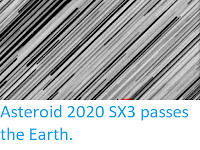Asteroid 2020 TH6 passed by the Earth at a distance of about 691 000 km (1.80 times the average distance between the Earth and the Moon, or 0.46% of the distance between the Earth and the Sun), at about 12.50 pm GMT on Sunday 18 October 2020. There was no danger of the asteroid hitting us, though were it to do so it would not have presented a significant threat. 2020 TH6 has an estimated equivalent diameter of 3-11 m (i.e. it is estimated that a spherical object with the same volume would be 3-11 m in diameter), and an object of this size would be expected to explode in an airburst (an explosion caused by superheating from friction with the Earth's atmosphere, which is greater than that caused by simply falling, due to the orbital momentum of the asteroid) more than 30 km above the ground, with only fragmentary material reaching the Earth's surface.
2020 TH6 was discovered on 15 September 2020 (three days before its closest approach to the Earth) by the University of Arizona's Mt. Lemmon Survey at the Steward Observatory on Mount Lemmon in the Catalina Mountains north of Tucson. The designation 2020 TH6 implies that the asteroid was the 163rd object (asteroid H6 - in numbering asteroids the letters A-Y, excluding I, are assigned numbers from 1 to 24, with a number added to the end each time the alphabet is ended, so that A = 1, A1 = 25, A2 = 49, etc., which means that H6 = (24 x 36) + 19 = 63) discovered in the first half of October 2020 (period 2020 T - the year being split into 24 half-months represented by the letters A-Y, with I being excluded).
2020 TH6 has a 372 day (1.01 year) orbital period, with an elliptical orbit tilted at an angle of 2.454.53° to the plain of the Solar System which takes in to 0.79 AU from the Sun (79% of the distance at which the Earth orbits the Sun) and out to 1.22 AU (1.22% of the distance at which the Earth orbits the Sun). This means that close encounters between the asteroid and Earth are fairly common, with the last thought to have happened in October last year (2019) and the next predicted in October next year (2021). It is therefore classed as an Apollo Group Asteroid (an asteroid that is on average further from the Sun than the Earth, but which does get closer). 2020 TH6 also has occasional close encounters with the planet Venus, which is last came close to in December 2018 and is expected to come close to again in March 2033.
See also...








